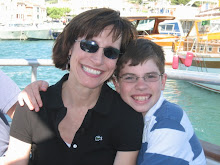
Thursday, May 28, 2009
Is this what cancer looks like?

Tuesday, May 26, 2009
And away go troubles down the drain...
Thanks to an over-achieving lymphatic system, Karen has had a build-up of fluid under her armpit causing it to swell to the size of a baseball. This has been a painful, though not a totally unexpected development. The doctor warned us that she would need to have the fluid -- lymphatic fluid -- drained a few times. But in just a week's time, she has had it drained five times. The procedure involves plunging a long needle into the incision and pulling out the fluid. The first time Karen was lucky to have her surgeon, Dr. Tchou, perform the procedure. But only a day later when it filled back up again, she was less fortunate and found herself in the hands of an incompetent ER doctor during the Memorial Day weekend.
As we sat in the ER waiting (and waiting, and waiting) I wondered how often we might find ourselves here in the coming months. I resigned myself to the fact that this would become a familiar place and I should get used to it. Everyone has their own ER horror stories and based on our first experience in quite some time, my fears were beginning to be confirmed. Short staffed and with few available beds, Karen laid for a couple hours in 14E, not in a room or even an area with a curtain...nope, on a gurney pushed up against the wall in the hallway. Take a number, lady! The doctor provided even less confidence. Unfamiliar with this type of recovery complication, he first tried to remove the fluid with a syringe. Finding this inadequate, he then applied the weight of his whole body onto the mass of fluid until it squirted across the room. Yes, there was some temporary relief, but it was clear he had probably done more harm than good and Karen quickly fled the ER.
The fluid continues to build up painfully under her arm and, as a result, Karen's doctor has directed her to make the 2 hr. trip by train to Penn to have it drained. We hope that the fluid is soon absorbed by her body and that this too shall this pass. In the meantime, she'll continue to need some Roto-Rooter treatment..."and away go troubles down the drain."
Friday, May 22, 2009
Cancer, Look Out!
Yesterday, we had our first meeting with Karen's medical oncologist, Dr. Kaplan-Tweed (the latest member of Karen's medical team). She's a terrific doctor. The kind who studies your case and history before she walks into the room, listens (imagine that?), and is willing to spend whatever time it takes to answer questions and make you comfortable (as comfortable as one gets with the topic of chemotherapy). And it doesn't hurt that she has a Facebook page with 79 friends. But trust me, I'm not planning on befriending her.
She had a sidekick named Jim -- another great doctor who is doing his fellowship at Penn. Turns out that young Jim remembered being honored by Governor Casey at the State Capitol for winning the Geography Bee. That was 1988. Jim was in 8th grade. Funny thing is that I was working for Governor Casey back then at the young age of 25. In fact, I probably wrote the proclamation honoring young Jim. And now here he is treating Karen.
So back to the chemotherapy. There's a lot to this (actually, about 4 pages of notes) that I won't get into here. It's overwhelming. This "journey" just took a brief ride through the "House of Horrors." In short, Dr. Kaplan-Tweed (and Jim) started by outlining a combination of two chemo drugs, Taxotere and Cytoxan (aka TC) that come with most of the expected (and some unexpected) side effects: hair loss, low white blood count which increased risk of infection, fatigue, mouth sores, neuropathy and, of course, the dreaded GI and nausea side effects. But keep in mind, Dr. Tweed assures us, "chemotherapy isn't what it used to be" (I can only imagine what it used to be like). What she means is that the side effects can be managed more effectively (not the hair loss, of course). There are other possible -- though more rare, side effects -- including your nails can turn black (or even your tongue....YUCK!) and some patients get leukemia (again, rare). They lay it all out for you...the good, the bad and the ugly.
But it gets better (well, not actually better, worse). Since Karen has triple negative cancer and she has a family history that includes breast, uterine and ovarian cancer and her tumor size is greater than 1 cm (I thought that was small), she's apparently a very good candidate for a clinical trial currently underway. Because triple negative cancer tends to be more aggressive and has a higher rate of recurrence, doctors are interested in finding new ways to treat this type of cancer. The clinical trial actually uses drugs that are already FDA approved. They're not new. In fact, the drug combination (Adriamycin, Cytoxan and Taxol) is currently being used to treat breast cancer. Researchers think that using these chemo drugs in combination with another drug called Avastin (which is currently used to treat colon cancer and metastatic breast cancer) may reduce the risk of recurrence for people with Karen's type of breast cancer and history. So, what's the downside? A longer, more intensive and toxic chemo regimen. Similar side effects, but perhaps more intense. The upside: possibly getting rid of her cancer once and for all . We'll have some time to consider this option over the next couple weeks.
This all probably sounds worse than it is (right?). Right. But, it's not unusual to hear and read all of this and be filled with stark fear of these toxins that race through your veins and make you so sick you wonder what's worse, the cancer or the chemo -- and I'm not even the patient.
Karen wants to crush -- no annihilate -- this cancer with whatever it takes. As a political consultant, Karen was known to go for an opponent's jugular. She knows how to fight. Cancer, look out!
Thursday, May 21, 2009
Lymph Notes
Even though we were scheduled to meet with Dr. Tchou this afternoon for a post-op appointment, she called early this morning to deliver the test results from the pathology report performed after surgery. Why was she calling when we would see her in a few hours? Was she preparing us for bad news?
But the news was good...well, mostly good. The lymph nodes they removed showed no indication that the cancer had spread. This was very good news since lymph node involvement is an important factor in determining the stage of the cancer. The bad news: Dr. Tchou was unable to get "clean margins" of normal tissue around the edges of the tumor during the surgery. This means there are still some cancer cells in the breast tissue and, possibly the chest muscle, that have to be removed. Another surgery (on June 3rd) will now be required to "re-excise" the incision to get the remaining cancer around the tumor site.
The pathology report also revealed that the tumor was a bit smaller than first estimated...coming in at about 1.2 centimeters (not 1.5 cm). That's smaller than an M&M. Is this significant? Not much.
So now that the doctor knows the tumor size and the results of the lymph node biopsy, she can determine the stage of the cancer. And the determination: Stage 1. This is great news since this is considered an early stage breast cancer.But unfortunately, none of this means Karen can call off the impending chemo treatments. The excitement over the early stage assignment is tempered by her worrisome "triple negative" diagnosis. Despite the small size of the tumor and the lack of cancer in the lymph nodes, chemo is required treatment for patients with "triple negative" cancer like Karen's (see posting "The bad news...if there is any bad news").
Thursday, May 14, 2009
Surgery
Though the surgery itself went well, Karen had a nasty reaction to the tracer dye used to locate the lymph nodes. Only 0.2% of patients have an adverse reaction to the dye. Guess who was in that 0.2%? When I came back to the recovery room to be with Karen she looked like she just ate a Volcano Double Burrito from Taco Bell. She was red...or maybe, orange. Or maybe red like a fire truck. More red than me...and I'm pretty red. And covered from head-to-toe with hives...big welts. She was a mess. (So much for that mini-facial exfoliation moisturizer thing she did this morning). They tried Benadryl, Hydrocortizone and a bunch of other drugs, including morphine. Nothing seemed to work. But, in time -- over 3 hrs -- it did start to improve. The redness slowly faded, but the hives were still driving her crazy. Exhausted and the last patient in the recovery room, she was wheeled to her hospital room at 8:30 p.m. What they expected to be an outpatient procedure ended up as an overnight in the hospital.
Wednesday, May 13, 2009
Beauty waits for no one






